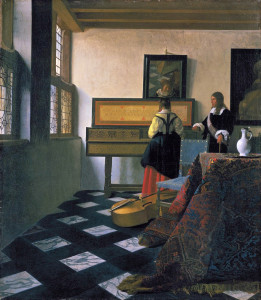
I found an interesting article about Tim Jenison, the founder of NewTek (owner of the 3D animation software I use, LightWave 3D). The article explains how Tim Jenison spent quite a few years studying the artwork of Johannes Vermeer (a 16th century painter), came to the conclusion that he must have used a “camera obscura” (mirror and lens contraption to project the scene onto his canvas), and then recreated the scene from a Vermeer painting to test his theory.
And now you can watch a movie about the entire process. Working with Penn and Teller (apparently Tim Jenison is a good friend of Penn), they financed and created Tim’s Vermeer, which chronicles his recreation of the scene from a particular Vermeer painting and then using the camera obscura to make his own version. The movie has already been released to theaters — I hope it winds up on Netflix streaming!
If Tim Jenison is correct and Vermeer used advanced tools to get such intricate detail into his paintings, does that diminish his work as a an artist? I do not believe so. He still had to choose his subjects, frame the scene within the canvas, and dedicate the time to recreating that carefully selected image into a painting.
If anything, I find it more inspirational that there is a historical record of using advanced tools in art. In modern times, there are plenty of tools available to create images: traditional methods such as ink, painting, and charcoal; photography and film for realistic representations; Illustrator, Photoshop, and other 2D computer programs; and of course, 3D modeling and animation programs like LightWave 3D and Maya. The decision by an artist to use any of these tools should be made by tool’s ability to translate the artist’s intent into the visual representation on the page/canvas/screen. The decision to use a tool should not impose artificial restrictions on the artist, preventing them from incorporating other tools to express their creativity.
